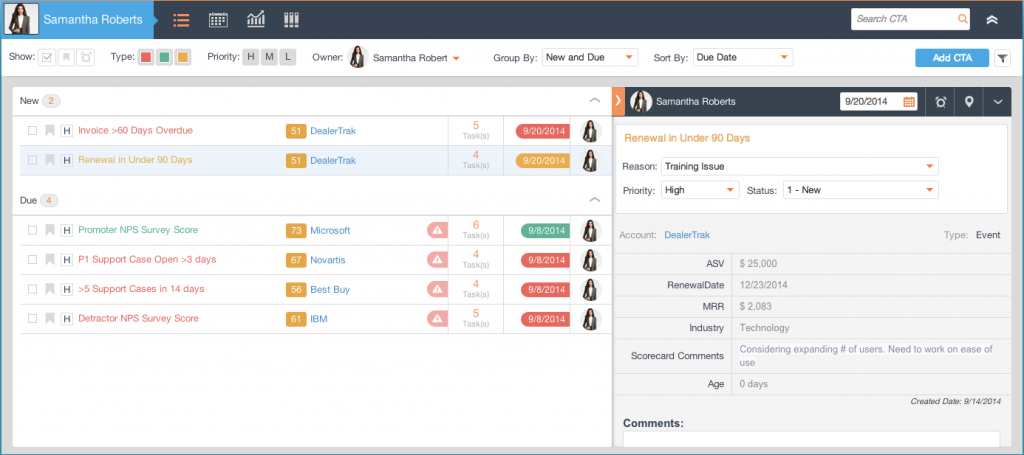There’s an abundance of data in every enterprise. There always has been but today, it’s much easier to extract and move around. One of the results of this is that most organizations are becoming more and more data-driven. Take Marketing for example. 10 years ago Marketing was perhaps the least measurable organization in the enterprise. Today they are arguably the most measurable with the growth of Marketing Automation tools and now predictive lead scoring tools as well.
Enter the new kid on the block – Customer Success. For the most part, an organization that did not even exist 10 years ago. But SaaS changed everything and turned the spotlight on customers and retention. SaaS also brought additional data to the table – data about how your customers use your product. These two forces came together at the same time and resulted in a misguided assumption – usage data was the ONLY thing that mattered in understanding and managing customer retention and trying to do anything without it was fruitless.
But let’s set the record straight. There is SO much customer health data in the enterprise that can be used to help manage retention, even without usage data. Great insight into customer health can be gained from the set of information that is almost always readily available – survey results, Support history, invoice history, Marketing engagement statistics, and many more.
And now enter one more factor that escalates the value of a Customer Success solution, even without usage data. Gainsight’s Cockpit. Gainsight’s Cockpit is the single place for the consolidation, communication, and collaboration of ALL Customer Success activities. Cockpit replaces the need for other organizational tools, time and activity tracking applications, as well as note-taking and collaboration functionality. It gives CSMs the ability to track all customer-facing activities so nothing ever falls through the cracks. It also provides Playbook functionality so that organizational best practices can be applied to every call-to-action. Just as importantly, Cockpit provides insight for management allowing them to see the risks, opportunities, and events associated with their customers. This improves renewal and upsell forecasting and enables more effective management of their Customer Success teams. Gainsight was built to help companies manage their customers but has become equally effective at helping to manage their customer-facing teams.
So, what does a solution look like with Gainsight and a limited set of non-usage data? Let’s take a look and see if it would be helpful. Let’s assume that the following information is consolidated in Gainsight:
- Historical survey results
- Support history
- Invoice history
- Customer renewal dates (if you have renewals)
Let’s also now assume that this customer uses Gainsight’s survey functionality to do surveys going forward. Now let’s see how Gainsight’s Cockpit brings this data into action and guides and tracks all CSM activities. Step one is to build some rules through the Gainsight Rules Engine so that customer intervention is triggered by specific customer actions or inactions. Let’s say the following rules are created:
- Trigger an Event call-to-action (CTA) when customer renewal is 90 days out
- Trigger a Risk CTA when customer opens more than 5 Support cases in 14 days
- Trigger a Risk CTA when a P1 Support case has been open more than 3 days
- Trigger a Risk CTA for every NPS survey score that is a Detractor (for CSM)
- Trigger an Opportunity CTA for every NPS survey score that is a Promoter (for Marketing)
- Trigger a risk CTA when a customer invoice is more than 60 days past due
Whenever any of these rule conditions are met, a CTA will be triggered and will appear in Cockpit for anyone – a CSM or Marketing in the case of the Promoter NPS score – to act upon. CSMs can also create manual CTAs for any customer-related tasks that they need to follow-up on and track. In addition, Playbooks will be automatically added to every CTA outlining the organization’s best practices for dealing with that exact situation. Any CTA, or task within a Playbook, can also be delegated to someone else in my organization. No more need for emails or meetings to request help from others to help me resolve customer challenges. It’s all in my Cockpit with additional collaboration via Chatter available, too.
Let’s also take this set of data plus one subjective data point (executive relationship) and create an automated health score. There are a myriad of ways to do this but here’s a simple example:
- # of P1 and P2 Support tickets in last 30 days (weighting 20%)
- NPS score (weighting 20%)
- # of risk CTAs open (weighting 30%)
- Executive relationship (weighting 30%)
With this setup, Gainsight’s Cockpit will show all open CTAs for every customer AND the set of tasks associated with each CTA. As these tasks are completed, management will have visibility into the progress being made to resolve those customer challenges. In addition, every customer now has a Health Score that will improve renewal and upsell forecasting and can also be used to drive additional customer intervention as needed. Look Ma – no usage data! But I do have a handle on my customer’s health and I have a system that is prioritizing customer interventions for me and telling me exactly what to do for each of those interventions. In addition, that same system is reporting my activities and progress against those activities, along with my customers’ health scores, to my management team. So you don’t have usage data. Or your data is dirty or really hard to get at. Start accelerating Customer Success without it. Consolidate what you can and use that to build a health score and proactively manage your customers. Gainsight’s Cockpit, Scorecard, and Rules Engine will give you everything you need to get started with what you have. And you most certainly have more useful information around customer health than you think you have. Why wait?
 Dan Steinman, Chief Customer Officer
Dan Steinman, Chief Customer Officer



